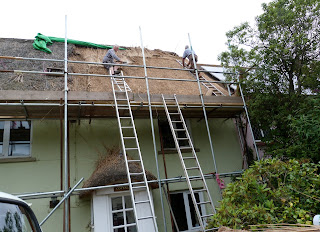
http://www.devon-thatchers.co.uk/
"
Hello! Welcome to the online home of Singleton Brothers, Devon Master Thatchers.
We can offer a prompt and knowledgeable service to home owners, builders and architects on projects from small porches and thatched features to listed buildings and large commercial developments.
We have carried out many projects over the years in locations as diverse as Florida, France and Guernsey as well as many parts of the UK.
Please take a look around our site, for more information please don't hesitate to get in touch."
"
Norfolk Reed and Thatching
Thatch is a traditional material that has been used for roofing in
Norfolk since prehistory. Whereas in some parts of the country straw
was used for thatch, the extensive reed beds of East Anglia gave our
ancestors access to a much more durable, locally grown material. To
this day most of the reed that is cut and bundled up in Norfolk
is sold to thatchers.
It is estimated that 80% to 90% of the reed used for thatching in the UK comes from abroad. Local cutters have to compete with the imported supplies and some have to pay landowners a royalty to harvest the reed. Many reed bed owners qualify for grant aid to manage reedbeds. Sadly, some reed beds previously managed to produce reed for thatching are now cut on a longer rotation.
Norfolk Reed does, however, have some advantages over the competition.
- As it grows in exposed, windswept beds it is a hardy plant which makes for a quality thatching material, lasting up to 70 years, much longer than some imported reed.
- As well as being strong, our local reed is more tapered than longer reed from hotter climates making it much more suitable for the rounded curves of English thatch.
- Because it is local, thatchers can check the quality of each crop before they buy it, rather than paying for an unseen shipment that gets dropped off on the day.
"
website of the North Norfolk Reedcutters Association





No comments:
Post a Comment
Hooray! You're posting a comment. Many thanks.